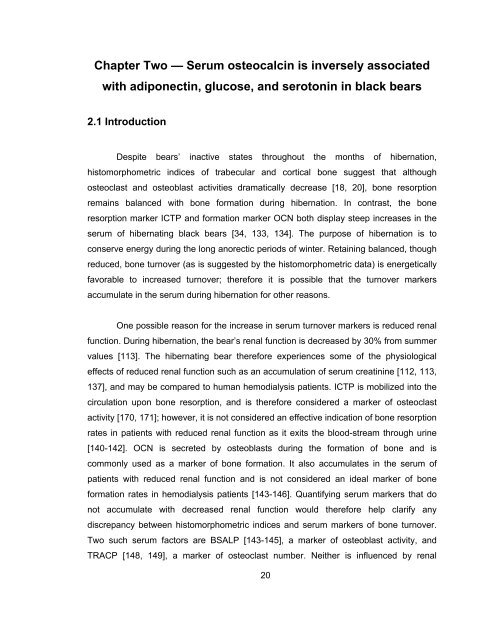C - Michigan Technological University
C - Michigan Technological University
C - Michigan Technological University
- No tags were found...
You also want an ePaper? Increase the reach of your titles
YUMPU automatically turns print PDFs into web optimized ePapers that Google loves.
Chapter Two — Serum osteocalcin is inversely associatedwith adiponectin, glucose, and serotonin in black bears2.1 IntroductionDespite bears’ inactive states throughout the months of hibernation,histomorphometric indices of trabecular and cortical bone suggest that althoughosteoclast and osteoblast activities dramatically decrease [18, 20], bone resorptionremains balanced with bone formation during hibernation. In contrast, the boneresorption marker ICTP and formation marker OCN both display steep increases in theserum of hibernating black bears [34, 133, 134]. The purpose of hibernation is toconserve energy during the long anorectic periods of winter. Retaining balanced, thoughreduced, bone turnover (as is suggested by the histomorphometric data) is energeticallyfavorable to increased turnover; therefore it is possible that the turnover markersaccumulate in the serum during hibernation for other reasons.One possible reason for the increase in serum turnover markers is reduced renalfunction. During hibernation, the bear’s renal function is decreased by 30% from summervalues [113]. The hibernating bear therefore experiences some of the physiologicaleffects of reduced renal function such as an accumulation of serum creatinine [112, 113,137], and may be compared to human hemodialysis patients. ICTP is mobilized into thecirculation upon bone resorption, and is therefore considered a marker of osteoclastactivity [170, 171]; however, it is not considered an effective indication of bone resorptionrates in patients with reduced renal function as it exits the blood-stream through urine[140-142]. OCN is secreted by osteoblasts during the formation of bone and iscommonly used as a marker of bone formation. It also accumulates in the serum ofpatients with reduced renal function and is not considered an ideal marker of boneformation rates in hemodialysis patients [143-146]. Quantifying serum markers that donot accumulate with decreased renal function would therefore help clarify anydiscrepancy between histomorphometric indices and serum markers of bone turnover.Two such serum factors are BSALP [143-145], a marker of osteoblast activity, andTRACP [148, 149], a marker of osteoclast number. Neither is influenced by renal20
















